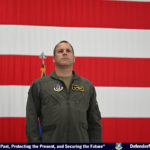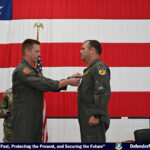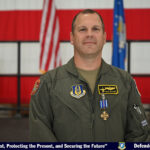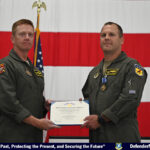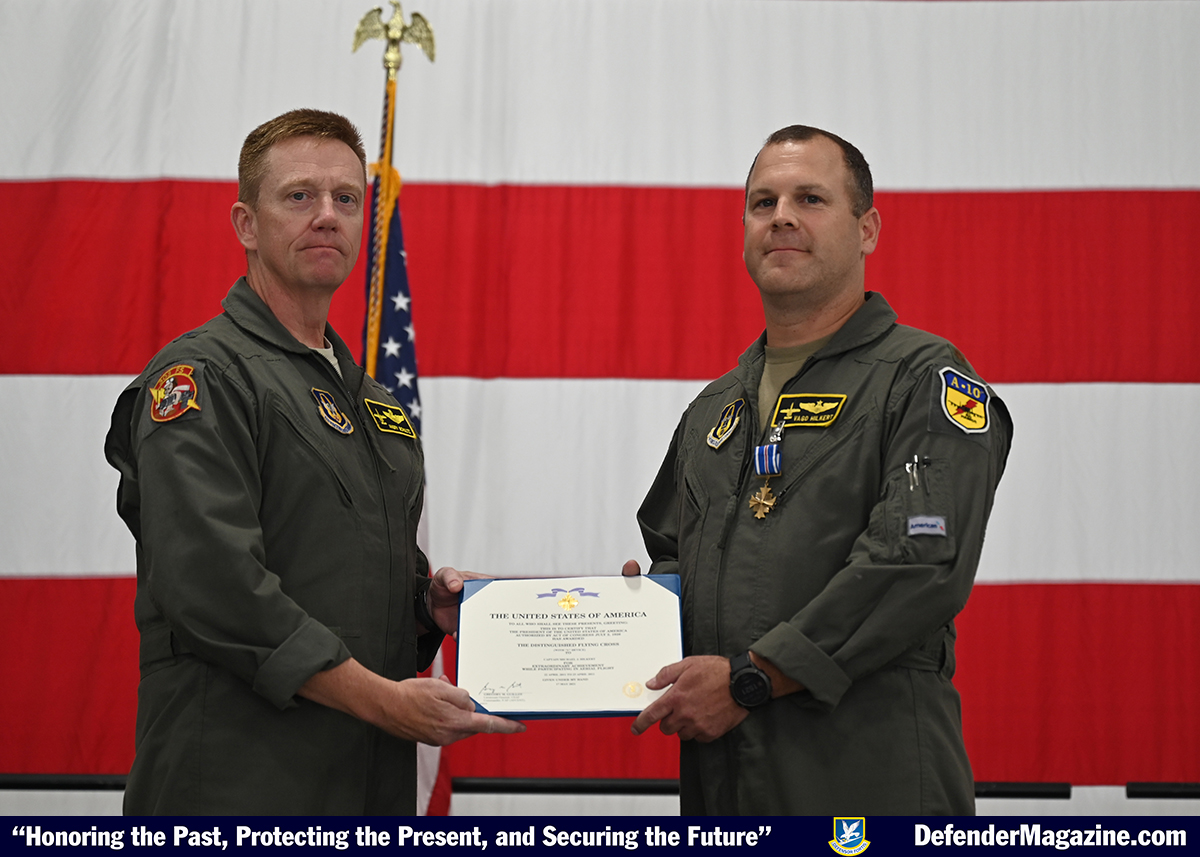WHITEMAN AIR FORCE BASE, Mo. —
“Any Hawg. Any Hawg on Guard, this is Dude 31.”
“Dude 31, this is Hawg 73.”
“We have a Fallen Angel in the Kapisa province, requesting air support.”
“Hawg 73, en route.”
“The distinguished flying cross is an aerial award that was established on July 2, 1926, by Congress in order to recognize any officer or enlisted member of the United States armed forces who distinguished themselves in support of operations by displaying heroism or extraordinary achievement while participating in aerial flight,” Lt. Col. Rick Mitchell, the 442d Operations Group deputy commander said, during a ceremony to award the distinguished flying cross to Maj. Mike “Vago” Hilkert Oct. 2, 2021, at Whiteman Air Force Base, Missouri.
In the early hours of April 23, 2011, two Guardian Angels – Pararescue Airmen who drop into combat areas to rescue U.S. or allied troops in dire situations – found themselves under heavy fire and unable to get back to their HH-60 Pave Hawk helicopters after dropping via hoist to support a downed U.S. Army helicopter in the Kapisa province of Afghanistan.
Enemy fire scored multiple hits on the Pave Hawks, whose call signs were Pedro 83 and 84.
Pedro 83 lowered three PJs down to a ridge a few hundred feet above the crash site, where they discovered one of the fallen helicopter’s pilots, who told them the other pilot was unconscious and still with the aircraft. Pedro 84 dropped its two PJs as close as it could to the crash.
“By and large, over the years,” Mitchell continued, “the preponderance of medals have been earned with the ‘V’ device, symbolizing it was earned through the blood, sweat, tears, and chaos of combat action.”
The PJs at the crash site, Staff Sgts. Zachary Kline and Bill Cenna, discovered the pilot still with the helicopter had died and began preparing him to be hoisted out. As Pedro 84 began to move after dropping the PJs, enemy fire struck the flight engineer in the leg and the Pave Hawk had to return to base to get him medical attention and pick up another engineer.
Meanwhile, Pedro 83 attempted to pick up their three-man team and the surviving pilot, but heavy enemy fire forced them to cut their hoist cable and circle around to try a different approach. Without a hoist to lift the people up to the helicopter, the pilot was forced to lower the HH-60 down to them in a daring one-wheel hover that allowed the PJs and the surviving pilot to climb aboard.
“For the context of this mission,” said Mitchell, “that this Distinguished Flying Cross is being awarded for, the other medals that have been awarded already to members of the armed forces include four Silver Stars – two of them to helicopter pilots, two of them to Pararescue Jumpers – and three Distinguished Flying Crosses with valor.
“So today will mark the fourth Distinguished Flying Cross awarded for what’s become known as one of the most intense combat rescue missions of the Afghanistan war.”
With Pedro 84 on the way back, Pedro 83 left the remaining PJs in the hands of over-watching AH-64 Apache helicopters and flew to the nearest forward operating base, FOB Morales-Frazier, to take on fuel and ammunition. When they set down, however, they discovered the aircraft had been heavily damaged and had lost most of its main transmission fluid. They made the call to return to Bagram Airfield and pick up a spare Pave Hawk.
Meanwhile, Kline and Cenna hunkered down behind a rock outcropping, pinned down by heavy enemy fire that caused the downed aircraft to go up in flames. Dodging bullets, the two bolted toward a nearby ravine before the fire sparked off the munitions still on the helo.
“Reflecting back on it,” said Mitchell, who was deployed with Hilkert at that time, “I can only imagine how Vago must have felt after likely consuming 3,000-plus calories of seafood and beef, and then carrying 10 RipIts in his flightsuit out of the chow hall, back to the Expeditionary Fighter Squadron, and then going and flying a 10-and-a-half hour sortie.
Hilkert arrived in the EFS on the evening of the 22nd and was assigned to support a ground assault force as they moved into an objective area. As he kept watch over that task force, however, a call came in over the Guard frequency.
“You need to understand that in a combat zone,” Mitchell continued, “using Guard is sacred – a last resort. A true sign that things are bad, and someone needs help. Meanwhile, the 74th Expeditionary Fighter Squadron weapons officer, Capt. Rustin “Trombone” Traynham… had been flying as Hawg 71 supporting another task force mission that night.
“As any good weapons officer I know would, he took action and decided to address the Fallen Angel, as he was the tactical expert and leader in the area that night. He took charge and reached out to the other A-10s on squadron common frequency. He chose the Sandy-qualified pilots to come rejoin with him and, eventually, Hawgs 71, 73 – then-Capt. Hilkert – and 74 – Lt. Col. David “Seymour” Haworth blended together to become Sandy 1 flight, signifying that they were now rescue mission commanders.
Sandy 1 flight arrived on the scene while Pedro 84 was on its way back to the fight. While the other A-10s began the search for the downed pilot and PJs, Hilkert set up airspace restrictions and communications relays to the Air Support Operations Center, Combined Air Operations Center, and Joint Personnel Recovery Center. While setting up the airspace, Sandy 1 fired rockets into the valley, buying Kline and Cenna a short reprieve from
About half an hour later, the enemy pinned Kline and Cenna down with renewed heavy machine gun fire at close range. Hilkert, while in the process of hooking up to the tanker to take on fuel, found the threat and marked the target 50 meters from the two PJs. Sandys 1 and 2 struck with their 30mm cannons, saving Kline’s and Cenna’s lives.
Later that morning, a 32-man U.S. Army quick reaction force landed half its people each at two different locations in the area to assist in the ground fight and immediately came under heavy enemy fire that killed one member and wounded more.
While locating enemy positions, Hilkert simultaneously monitored the location of one half of the QRF with his binoculars, and the other with his targeting pod. He kept the rest of the aircraft apprised of their positions to allow the Apache helicopters to strike without hitting friendlies. Additionally, he coordinated for a tanker overhead and assigned Intelligence, Surveillance, and Reconnaissance assets to search for enemy positions in the surrounding area.
All-told, Hilkert coordinated the efforts of more than 21 aircraft in “the stack” that night. He tracked multiple enemy positions and communicated over more than 37 different frequencies.
Meanwhile, the Pedros and two Apaches in a four-ship rescue formation, supported by Hilkert and Haworth, picked up a wounded member of one of the QRFs. As they took heavy fire, they were forced time and again to pull back and reset the formation, until the Apaches destroyed the enemy position with their Hellfire missiles. Despite observing nine surface-to-air fires, Hilkert continuously put his aircraft within range of the enemy to draw fire away from the rescue formation. Pedro 83 was finally able to land and extract the wounded soldier.
Later, after the original Sandy flight swapped out with four day-shift A-10s, Pedro 84 successfully hoisted out Kline and Cenna, who insisted on sending up the litter with the fallen pilot before being lifted to safety themselves.
Hilkert’s skill and vigilance led to the securing of two landing zones, rescuing the two Guardian Angels, and recovering the downed pilot and evacuation of the 32 soldiers in the QRF team.
“It’s bittersweet,” Hilkert said about receiving the DFC. “I’m honored to be amongst a group of heroes that did their best with a bad situation. Several people lost their lives during this mission, so it wasn’t all high fives when we got home. We flew back to Kandahar in silence.”
Brig. Gen. Mike Schultz, the 442d Fighter Wing commander, who was the director of operations on shift that night for the 74th EFS, also spoke at the ceremony.
“What they did that night is truly amazing,” he said. “Truly outstanding. And those guys deserve to stand with any single Sandy that has ever been or ever will be because of the actions they did that night.”
By Master Sgt. Bob Jennings, 442d Fighter Wing Public Affairs / Published October 28, 2021

